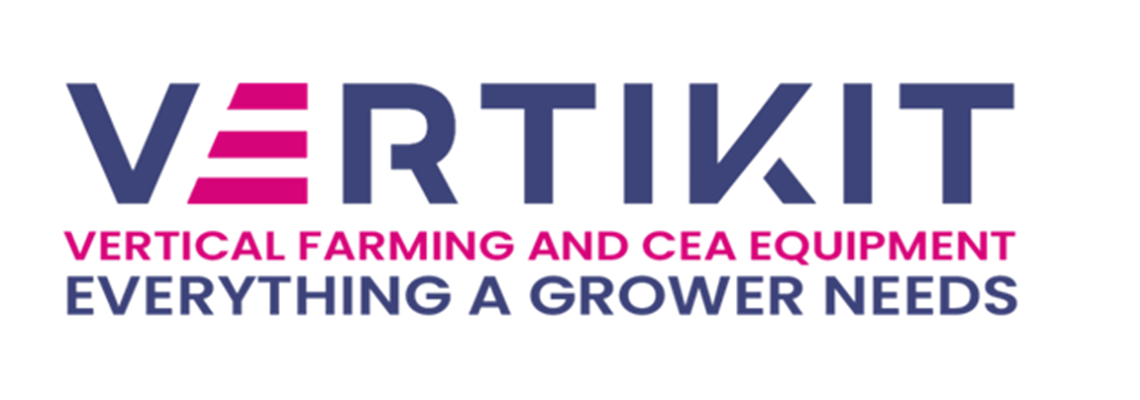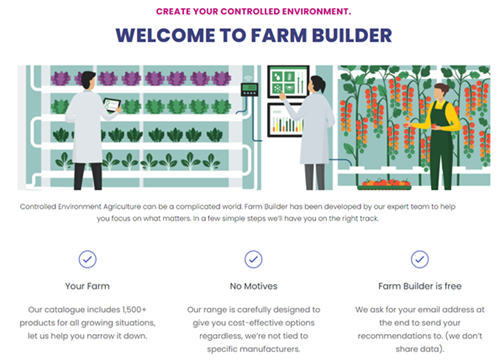Controlled Environment Agriculture Article & Vertikit Case Study
Thursday, 11 November 2021

Dr William Stiles, Aberystwyth University and Vertikit
Vertical Farming (VF) and Controlled Environment Agriculture (CEA) are the fastest developing areas of food production, and this approach is expected to become a major component of horticultural production in the future. The principle is based on modifying environmental conditions to create the optimal growing environment for a given plant, thus offering that plant the perfect conditions for growth.
The application of this technology has the potential to improve food production in a period when environmental change may make field-based production increasingly challenging, and when improving food security through developing more local supply chains is increasingly important. Additionally, controlled growing systems can enable growers to limit the environmental impacts of current horticultural production activities, offering a win-win scenario.
The controlled growing sector is highly dynamic. The size of the vertical farming market globally in 2020 is estimated to be around USD 3 billion, and is projected to grow to around USD 6-10 billion by 2025 (estimates vary, but are typically within this range). This figure may well be a conservative estimate, as such production systems are comprised of numerous, high-value, technical components, and the lighting component marketplace alone can already boast comparable figures (globally, the horticulture lighting market was estimated in 2020 to be USD 2.3 billion and is projected to grow to USD 6 billion by 2025). Estimations of future scope beyond the next five years are variable, but predictions that this sector could have a global value in the region of £100 billion in twenty years are increasingly common.
These estimations are well founded. In the near future, as the demand for food and food security continues to increase, and the ability to produce foods in areas which are currently depended upon begins to falter, subject to impact of climate change, this sector can be expected to achieve substantial growth and will continue to attract significant interest and investment from multiple actors, both public and private.
However currently, development in this sector remains problematic as integrating this technology into new and existing growing systems is considered technologically and financially challenging.
What is Vertikit?
Vertikit aims to be a response to the dual issue of access to technology, and suitable translation of equipment application. This is an issue for the fledgling CEA sector and it is primarily a challenge for small to medium growers, both for existing organisations trying to incorporate this new approach, and new entrants just starting out. For larger horticultural enterprises, those with sufficient technical insight and sizeable buying power, access to this technology poses only a mild challenge. But at the smaller-business end of the spectrum, things are less easy.
At this moment in time there is an apparent contradiction: seemingly endless information on the technology available, and none that offers straight answers. There are many competing voices in the industry, and the current ‘turn-key’ options, from container farms and beyond, make clarifying a grower’s own individual strategy complex. Similarly, for those just beginning to consider this approach to growing, in the case of the options available, the conversation may well stop dead at the ‘how much does it cost?’ stage.
Yet this industry is evolving quickly, and increasingly manufacturers from similar or comparable industry sectors are starting to apply their existing technologies to the business of protected horticulture. Consequently, there is now enough technology available from individual manufacturers that it is entirely possible to build your own farm. The challenge is now becoming one of technology translation. What lights are right for your system? How much dehumidification will be needed? How does monitoring equipment work? And endless other specific questions. Whilst there are a raft of blog posts and ‘how-to’ articles available on the web for what you need to setup a grow environment, these are often of dubious accuracy.
Vertikit answers these challenges by offering a one-stop shop solution. It can be used by growers as a complete farm building tool, a supplies shop, and an information centre. Vertikit showcases the very best technology from the CEA sector, which is curated and explained by scientists and industry professionals. An important part of this approach is independence. Vertikit is entirely independent and is not affiliated or tied to any specific manufacturer. The equipment showcased is comprehensive and aims to offer as many different options for growers as there are crop production strategies. The site will explain how each component for a controlled farm works, and link the components together where helpful. There will be sufficient information made available, both on the site and via access to experts, to allow growers to make informed choices, but ultimately, the decision on what is right for a given growing system will be up left to the grower. This is a support tool, not a sales tool.
Vertikit Farm Builder:
Vertikit’s Farm Builder tool is designed help growers narrow down the equipment that is right for the growing environment and system they aim to create. Currently there are over fifteen hundred individual products in the Vertikit system. Farm Builder helps growers to select equipment which is relevant based on the type of system (multi or single level), type of growing environment (natural or artificial light), and the size of the growing space. These different scenarios require quite different equipment options. Farm Builder saves growers time, offers initial support, and allows growers to begin the process of planning the system they wish to construct.
The first version of this tool is available currently, but this will continually be refined in order to achieve ever greater efficiency and accuracy. It is intended that ultimately growers can input highly specific information in this tool, from crop type to idiosyncrasies of the growing environment, and be offered very specific outputs with regard to the equipment and technology that would work best for their systems.
Vertikit Knowledge centre:
The Vertikit Knowledge Centre will populate rapidly as the site develops, and is designed to become a repository of technical information on the science of CEA and vertical farming. Additionally, this resource will offer a mix of information, from highly specific, technical insight translated into article form, to more general media including industry news (where relevant) and reviews of equipment, across written, video and audio forms. The purpose of the Knowledge Centre is to offer a platform for growers which can be used as a trusted source of information, and to present that information in a wide array of mediums to ensure that, regardless of preferred learning style, there is something for everyone.

In future this may also expand to include a forum-style interface to allow peer-to-peer sharing of ideas, which is an important component in knowledge exchange.
Summary:
The aim of Vertikit is to increase the uptake of CEA and VF in the UK by increasing the accessibility to technology, with appropriate translation, at a price level which is not beyond the capacity of the average small to medium grower, or at a capital investment level which is compatible with likely return on investment. This will enable the development of local growing systems and allow growers to engage with this technology on a more achievable basis.
In a way the above challenge is a major issue for the new CEA sector more generally, as industries are rarely ever developed from the top-down. Typically, successful organisations grow from the bottom-up, perfecting their systems until there is an approach which is successful at scale. With the advent of large factory-style farms that arise fully-formed, questions are raised as to their long-term stability: have they bypassed too much incremental learning on the way to scale, or will they be able to solve the myriad challenges that a growing environment at production scale will present? Working with the organisms in such a system, both those desired and those less welcome that inevitably find a way in, will present many challenges.
At Vertikit we believe that the future of technology must come as a result of growers, new and existing, experimenting with what works for their crop and environment. Perhaps a person experimenting with growth recipes in a garage somewhere will develop the approach which is optimal. Or perhaps the sheer weight of different mini endeavours will see this sector move towards growing crops which are currently considered unsuitable. Regardless, Vertikit aims to support the industry as it develops by sharing as much knowledge and insight as possible, to allow the grower to keep growing in every sense.
